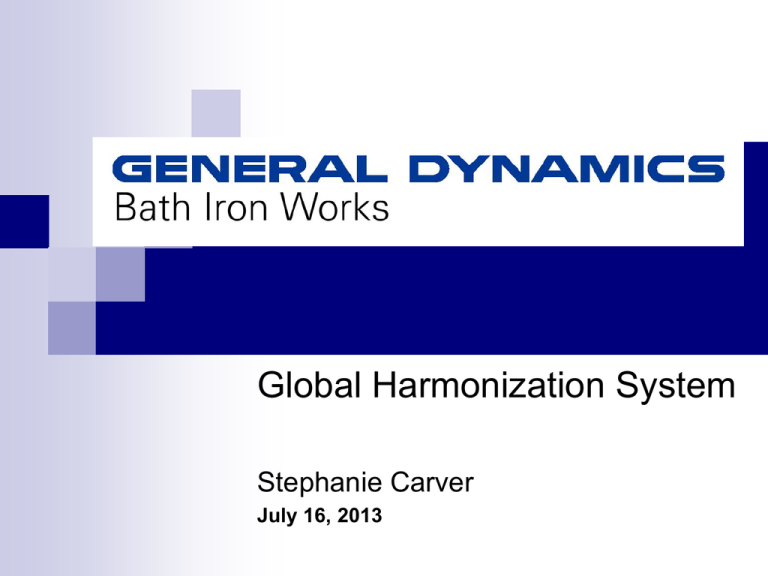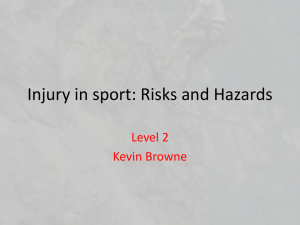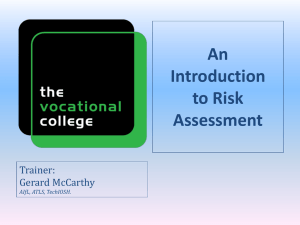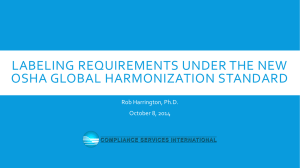- Marine Chemist Association
advertisement

Global Harmonization System Stephanie Carver July 16, 2013 Agenda Haz Com 2012 GHS Overview Revised Definitions Hazard Classifications Labeling SDS Time Line September 30, 2009 Proposed Rule in the Federal Register March 26, 2012 Final Rule published in the Federal Register Effective Dates December 1, 2013 – employee training June 1, 2015 – classification, labeling and SDS implementation December 1, 2015 – no longer ship with old labels June 1, 2016 – additional employee training for newly identified hazards GHS Overview Based on UN program to develop a standard system for classifying and communicating hazards for chemicals This will affect employees, consumers, transportation and emergency responders These changes to Haz Com with help ensure there is a clear, defined means of communicating hazards globally GHS Overview Significant overhaul of HCS Inclusion of other hazards and provisions for HNOC Adoption of GHS classification and labeling SDS format and specific content requirements GHS Overview DOT (Department of Transportation), EPA (Environmental Protection Agency) and CPSC (Consumer Product Safety Commission) were actively involved in developing GHS DOT has already modified their requirements for classification and labeling to be consistent with GHS EPA using in the DfE Program Best Practices approach Overview of New HCS Affected 29 CFR Parts 1910 (General), 1915 (Shipyard) and 1926 (Construction) Significant Changes to HCS Terminology and definitions Define substance and mixture Classification not determination Classification according to GHS Labeling SDS GHS “shall” will replace “should” under OSHA Revised Definitions Chemical Any substance or mixture of substances Hazardous Chemical Any chemical which is classified as a physical hazard or a health hazard, a simple asphyxiant, combustible dust, pyrophoric gas, or hazard not otherwise classified vs. old language: “any chemical which is a physical hazard or a health hazard” Physical Hazards – definitions deleted and placed in a new Appendix B Revised Definitions Simple asphyxiant Substance or mixture that displaces oxygen Combustible dust No definition but rather a reference to OSHA’s “Hazard Communication Guidance for Combustible Dusts”(3371-08-2009) and Combustible Dust National Emphasis Program Directive CPL 03-00-008 Pyrophoric gas A chemical in gaseous state that will ignite spontaneously in air at a temperature of 130oF (54.4oC) or below Revised Definitions New Terms Hazard category and subcategory HNOC Hazard statement Label elements Pictograms Precautionary statements Product identifier SDS Signal word Revised Definitions Hazard Category and Subcategory The division of criteria within each hazard class. These categories compare hazard severity within a hazard class and should not be taken as a comparison of hazard categories. Example: Toxicity old HCS defined as “not”, “slight”, “toxic” New HCS has Categories 1 – 4 based on ATE for each category Revised Definitions HNOC Not Otherwise Classified – formerly called “Unclassified Hazards” Hazards covered under hazcom but not currently addressed by the GHS Not required to be on the label but will be required to be listed in Section 2: Hazard Identification of the SDS Must be addressed in worker training Hazard Revised Definitions HNOC Must be assessed when the manufacturers and importers evaluate physical and health hazards Pyrophoric gases, simple asphyxiants and combustible dust were removed from unclassified (HNOC) and are addressed individually Must be addressed on labels where appropriate Classification means to identify the relevant data regarding the hazards of a chemical; review those data to ascertain the hazards associated with the chemical; and decide whether the chemical will be classified as hazardous according to the definition of hazardous chemical in this section. In addition, classification for health and physical hazards includes the determination of the degree of hazard, where appropriate, by comparing data with the criteria for health and physical hazards. Classification Manufacturers and importers are required to reevaluate chemicals according to the new criteria in order to ensure the chemicals are classified appropriately. This pertains to the product not the individual chemicals (paint is not evaluated as a combustible dust) Health hazards – assign the chemical both a hazard category and subcategory Physical hazards – new criteria consistent with current DOT requirements Classification Health Hazards 1910.1200 Appendix A – Health Hazard Criteria Outlines the process for determining hazards Extensive so more time consuming for manufacturers Revised Definitions Hazard Statement Assigned to a hazard class and category that describes the nature of the hazard(s) of a chemical including, where appropriate, the degree of hazard Signal word One of two words used to distinguish between hazard levels and emphasize the extent of the hazard DANGER or WARNING Revised Definitions Pictograms A visual depiction that may include a symbol and other graphic elements intended to convey specific information Eight designated under this standard for hazard category Red borders required on all labels Pictograms • Flammables • Pyrophorics • Self heating substances & mixtures • Substances & mixtures when in contact with water emit flammable gases • Organic peroxides Defines flammability Pictograms • Oxidizers Defines an Oxidizer A chemical which may, generally by providing oxygen, cause or contribute to the combustion of other material Pictograms • Gases under pressure Defines all types of gases Pictograms Defines Explosives Self-reactives Organic Peroxides Pictograms • Skin corrosion, burns • Eye damage • Corrosives to metals Defines both physical & health hazards • Corrosive to metals • Corrosive to skin or eyes Pictograms • • • • • • Defines chronic & specific long term type effects Carcinogen Mutagenicity Reproductive toxicity Respiratory sensitizer Target organ toxicity Aspiration toxicity Pictograms • Acute toxicity Defines acute toxicity (fatal or toxic) Toxicity based on LD50 and other lab based testing Pictograms Defines lower level toxicity and irritation effects • • • • Irritant to skin & eyes Skin sensitizer Narcotic effects Respiratory tract irritant • Hazardous to ozone layer (not mandatory) Pictograms • Based on aquatic toxicity only • Chronic based on toxicity & persistence in the environment Defines Aquatic Toxicity (Optional) Revised Definitions Precautionary Statements Phrases that describe measures recommended to minimize or prevent adverse effects resulting from exposure, improper storage or handling Product Identifier The name of the product and any other manufacturer reference (ie code number) Revised Definitions Label Elements Product Name and Codes (SDS Sections 1, 3, 14) Pictogram (SDS Section 2) Hazard statement (SDS Section 2) Signal word (SDS Section 2) Precautionary statement (SDS Section2) Supplier Information (SDS Section 1) Revised Definitions Label Elements Revised Definitions Label Differences Current OSHA Template • Identity of hazardous chemical • Hazard warnings • Contact information for manufacturer/importer/responsible party. GHS Template • Product Identifier • Pictograms • Signal word • Precautionary Statements • Hazardous Statements • Supplemental Information • Supplier Identification Revised Definitions Safety Data Sheet 1. 2. 3. 4. 5. 6. 7. 8. 9. 10. 11. 12. 13. 14. 15. 16. Identification Hazard Identification Composition / information on ingredients First aid measures Fire fighting measures Accidental release measures Handling and storage Exposure controls / personal protection Physical and chemical properties Stability and reactivity Toxicological information Ecological information Disposal considerations Sections 12-15 outside OSHA Transport information Regulatory information Other information including preparation and revision dates HCS Continues ACGIH TLV’s continue to be required by OSHA Information on carcinogenicity classifications by IARC and NTP Process for handling trade secret information is not changed Impacts Manufacturers/Importers Re-classification to meet new standards Create new SDS/Labels Ensure documents are distributed Employers Manage new SDS Classification impacts Container labeling Re-educate workers Maintain up to date information Implementation Dates December 1, 2013 employee training June 1, 2015 classification, labeling and SDS implementation December 1, 2015 no longer ship with old labels June 1, 2016 additional employee training for newly identified hazards Employee Training at BIW GHS??






